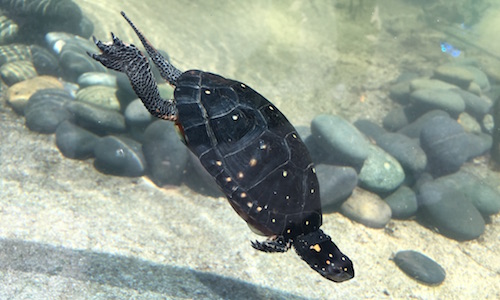Appearance:
Spotted turtles are small, semi-aquatic turtles. They have distinct yellow spots that cover their limbs and shell. Their carapace (top part of shell) is typically black and not highly domed. The turtle's plastron (bottom part of shell) is yellow and black. Males have a darker pigment on the hard portion of their jaws, while females have a yellowish coloration. Males tend to have brown eyes, whereas females' eyes are often orange.
Size:
Shell length: 3.5 – 5 inches
Diet:
Spotted turtles are omnivorous. Their diet mainly consists of snails, worms, slugs and spiders, but it can also include aquatic vegetation and green algae.
Reproduction:
Breeding season is in mid-spring. During this period, males engage in an active, almost frenzied pursuit of females. Multiple males may attempt to pursue a single female. When the female is ready for mating, she lets one male catch her and they mate.
Incubation:
Nesting typically occurs in May. Female spotted turtles may wander far from their breeding pools in search of nesting sites. An open site such as a meadow or field is usually chosen for the nest. She lays three to seven eggs and uses her body to smooth the dirt after burying them. Eggs hatch 70-80 days later.
Behavior:
Daylight hours are spent eating or basking. During the evening, spotted turtles retreat into the water and spend the night on the bottom of the pond. Turtles hibernate in groups during the winter, often returning to the same hibernation site year after year.
Role in their habitat:
Prey species. They are particularly vulnerable to raccoons or muskrats.
Habitat/range:
The spotted turtle occupies a variety of habitats including bogs, marshes, woodland streams, vernal pools, swamps and sedge meadows. They can also be found in some brackish streams. These turtles range from parts of Canada, as well as south along the eastern United States, extending to Florida.
Median Life Expectancy:
25-30 years in the wild
Fun Facts:
- Spotted turtles have been known to walk long distances over land to reach nesting sites, often crossing roads and developed areas.
- Temperature effects embryonic development. Some researchers claim that the effects of climate change may severely impact population sex ratios.




